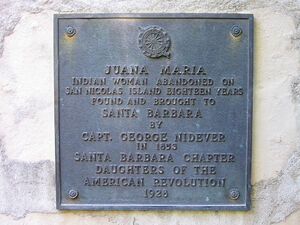Biography
Juana Maria (Her Native American name is unknown) was born before 1811 on the island of San Nicolas. In 1811 native Alaskan hunters were dropped off on the island where they quickly entered into conflict with the Nicoleño and as result devastated the tribe's population. In 1835 the mission padres of California ordered that the few remaining residents of the island were to be moved to the mainland for their survival. Though the exact circumstances of how are unknown, one woman was accidently left behind during the relocation and no immediate attempts to rescue her were ever made. Eighteen years later, in 1853, fur trappers led by Capt. George Nidever, who had previously attempted to find her but failed, landed on San Nicholas Island and finally located it's lone inhabitant. She was the last known surviving member of the Nicoleño tribe. She was the subject for the children's book written by Scott O'Dell titled, "Island of the Blue Dolphins" which won a Newbery Medal in 1961 and is considered a minor classic. She passed away shortly after being rescued in 1853.
From her bio on Wikipedia:
"Just seven weeks after arriving on the mainland, Juana Maria died of dysentery in Garey, California. Nidever claimed her fondness for green corn, vegetables and fresh fruit after years of little such nutrient-laden food caused the severe and ultimately fatal illness. Before she died, Father Sanchez baptized and christened her with the Spanish name Juana Maria. She was buried in an unmarked grave on the Nidever family plot at the Santa Barbara Mission cemetery. Father González Rubio made the following entry in the Mission's Book of Burials: "On October 19, 1853 I gave ecclesiastical burial in the cemetery to the remains of Juana Maria, the Indian woman brought from San Nicolas Island and, since there was no one who could understand her language, she was baptized conditionally by Fr. Sanchez." In 1928, a plaque commemorating her was placed at the site by the Daughters of the American Revolution."
"Juana Maria's water basket, clothing and various artifacts, including bone needles which had been brought back from the island, were part of the collections of the California Academy of Sciences, but were destroyed in the 1906 San Francisco earthquake and fire. Her cormorant feather dress was apparently sent to the Vatican, but it appears to have been lost."
BURIAL: Mission Santa Barbara Cemetery in Santa Barbara, Santa Barbara County, California
Find A Grave: Memorial #48021879 Juana Maria
Archaeological Finds
"In 1939, archaeologists discovered Juana Maria's whale-bone hut on the northernmost end of San Nicolas, the highest point of the island. The location of the hut exactly matched the descriptions left by Nidever. In 2012, archaeologist Steven J. Schwartz reported finding a site that may have been Juana Maria's cave. In 2009, University of Oregon archaeologist Jon Erlandson found two Nicoleño-style redwood boxes eroding from a sea cliff, covered by a whale rib and associated with several asphaltum-coated woven water bottles, and threatened with destruction from winter storms. The site is located on the northwest coast of San Nicolas, where Juana Maria is believed to have spent much of her time. The boxes, salvaged by Erlandson, René Vellanoweth, Lisa Thomas-Barnett, and Troy Davis, contained more than 200 artifacts, including bird-bone pendants, abalone shell dishes and fish hooks, soapstone ornaments, sandstone abraders, red ochre, a Nicoleño harpoon tip, glass projectile points and metal artifacts, and several Native Alaskan toggling harpoon tips. In 2012, Navy archaeologist Steven Schwartz, working with Vellanoweth and his students from California State University, Los Angeles, found and uncovered the buried remnants of the long-lost Indian Cave, where Juana Maria may also have lived. Archaeological research at the cave has been halted, however, at the request of the Pechanga Band of Luiseno Indians, which claims cultural affiliation with the island's ancient residents. " Source: Wikipedia
Sources
http://www.nps.gov/chis/photosmultimedia/california-islands-symposium.htm
https://en.m.wikipedia.org/wiki/Island_of_the_Blue_Dolphins
Wikipedia for Juana Maria https://en.wikipedia.org/wiki/Juana_Maria
Wikipedia for The Nicoleño https://en.wikipedia.org/wiki/Nicole%C3%B1o
No known carriers of Juana's ancestors' DNA have taken a DNA test.
Have you taken a DNA test? If so, login to add it. If not, see our friends at Ancestry DNA.


